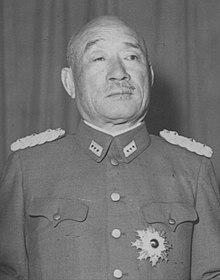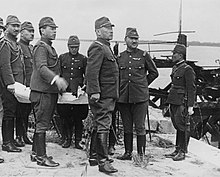Hajime Sugiyama
 From Wikipedia the free encyclopedia
From Wikipedia the free encyclopedia
This article includes a list of general references, but it lacks sufficient corresponding inline citations. (July 2020) |
You can help expand this article with text translated from the corresponding article in Japanese. (November 2024) Click [show] for important translation instructions.
|
Hajime Sugiyama | |
|---|---|
杉山 元 | |
 | |
| Minister of the Army Empire of Japan | |
| In office 9 February 1937 – 3 June 1938 | |
| Monarch | Shōwa |
| Prime Minister | |
| Preceded by | Kōtarō Nakamura |
| Succeeded by | Seishirō Itagaki |
| In office 22 July 1944 – 7 April 1945 | |
| Prime Minister | Kuniaki Koiso |
| Preceded by | Hideki Tojo |
| Succeeded by | Korechika Anami |
| Chief of the Imperial Japanese Army General Staff | |
| In office 3 October 1940 – 21 February 1944 | |
| Monarch | Shōwa |
| Prime Minister | |
| Preceded by | Prince Kan'in Kotohito |
| Succeeded by | Hideki Tojo |
| Personal details | |
| Born | January 1, 1880 Kokura, Fukuoka Prefecture, Japan |
| Died | September 12, 1945 (aged 65) Tokyo, Japan |
| Awards | Order of the Golden Kite, Order of the Rising Sun |
| Military service | |
| Allegiance | |
| Branch/service | |
| Years of service | 1901–1945 |
| Rank | |
| Commands | 12th Division Northern China Area Army First General Army |
| Battles/wars | |
Hajime Sugiyama (杉山 元, Sugiyama Hajime / Sugiyama Gen, January 1, 1880 – September 12, 1945) was a Japanese field marshal and one of Japan's military leaders for most of the Second World War.
As Army Minister in 1937, Sugiyama was a driving force behind the launch of hostilities against China in retaliation for the Marco Polo Bridge Incident. After being named the Army’s Chief of Staff in 1940, he became a leading advocate for expansion into Southeast Asia and preventive war against the United States.
Upon the outbreak of hostilities in the Pacific theater of World War II, Sugiyama served as the army’s de facto commander-in-chief until his removal by Prime Minister Hideki Tojo in February 1944. Following Tojo's ouster in July 1944, he once again held the post of Army Minister in Kuniaki Koiso's cabinet until its dissolution in April 1945. Ten days after Japan's surrender on 2 September 1945, he committed suicide.
Early life and career
[edit]This section needs additional citations for verification. (September 2022) |
Born to a former samurai family from Kokura (now part of Kitakyushu City), Fukuoka Prefecture, Sugiyama graduated from the 12th class of the Imperial Japanese Army Academy in 1901. He served as a junior officer with 3rd Battalion of the 14th Regiment of the IJA 12th Division in the Russo-Japanese War,[1] and was wounded in the face during the Battle of Shaho. Due to scars from that injury, he was unable to fully open his right eye.
After graduating from the 22nd class of the Army Staff College in 1910, Sugiyama served in Section 2 (Intelligence) within the Imperial Japanese Army General Staff. He was posted as military attaché to the Philippines and Singapore in 1912, disguised as a civilian trading company employee, and disguised as an Imperial Japanese Navy lieutenant, joined in an inspection tour of the United States Navy base at Subic Bay. Promoted to major in 1913, he was posted again as military attaché to British India in 1915, where he met in secret with Indian independence activists Rash Behari Bose and Subhas Chandra Bose. In 1918, he was sent as a military observer to the Middle Eastern theatre of World War I. At the end of the war, he served on the League of Nations committee on military aviation.
On his return to Japan, Sugiyama was promoted to lieutenant colonel, and commander of the 2nd Air Battalion in December 1918. Three years later in 1921, he was promoted to colonel. A strong proponent of military aviation, he ultimately rose to become the first head of the Imperial Japanese Army Air Service in 1922.
Rise to power
[edit]This section needs expansion. You can help by adding to it. (October 2024) |
Involvement in Army politics
[edit]In 1924, Sugiyama became a protege of Army Minister Ugaki Kazushige. [citation needed] Subsequently, he was promoted to major general in May 1925 and appointed Director of the Bureau of Military Affairs in 1928. Within the same timeframe, he also became a leading figure in the Army's Control Faction, the Tōseiha.[2]
In 1931, he participated in the March incident, a failed coup-d'etat which attempted to make Ugaki Prime Minister. Later that year, as Under Secretary of the Army, he made an official announcement defending the actions of the military in the Mukden Incident.[citation needed]
With the rise of the rival Kōdōha faction under Sadao Araki to the post of Army Minister, Sugiyama was sidelined to the Imperial Japanese Army Air Service in March 1933. However, the failed coup d'etat of the February 26 incident in 1936 led to a purge of the Kōdōha from positions of authority and Sugiyama was promoted to full general in November 1936.[3][failed verification]
Army Minister
[edit]
In February 1937, Sugiyama became Army Minister in the cabinet of Prime Minister Senjūrō Hayashi and remained in that position under the succeeding Prime Minister, Fumimaro Konoe.[4]
During his tenure, tensions between Japanese forces and the Chinese grew more severe. When hostilities broke out near the Marco Polo Bridge, Sugiyama pushed Konoe for retaliation against China, thereby giving rise to the Second Sino-Japanese War.[citation needed].
Promotion to Army leadership
[edit]On 3 June 1938, Sugiyama left his position as Army Minister to become a member of Japan's Supreme War Council.[5] In December 1938, he briefly left the Council to assume command over the North China Area Army and the Mongolia Garrison Army respectively before returning in September 1939.[6][4]
By September 3, 1940, Hajime Sugiyama succeeded the elderly Prince Kan'in Kotohito as Chief of the Imperial Japanese Army General Staff. [7]
World War II
[edit]This section needs expansion. You can help by adding to it. (September 2022) |

On the eve of the Second World War's expansion into Asia and the Pacific, General Sugiyama was one of the leading Army officers lobbying for war with the West.[8] On September 5, 1941, Emperor Hirohito challenged his confidence in a quick victory over the Western powers by berating him for erroneously predicting in 1937 that Japan's invasion of China would be completed within three months.[7][9][page needed] Nonetheless, by 1 December 1941, the Emperor ultimately gave his imperial sanction for war. [10]

Following the war’s outbreak, Sugiyama was responsible for directing the Army’s ensuing military operations.[11][12] In a matter of months, the Empire of Japan conquered a broad swathe of territory in Southeast Asia and the western Pacific including Malaya, the Dutch East Indies, Burma, and the Philippines.[13][14]
By the beginning of 1943, the tide of the conflict had turned against the Japanese after their forces were decisively defeated at the battles of Midway and Guadalcanal.[15][16] In the same year, Sugiyama was awarded the honorary rank of field marshal.[7]
As the war fronts collapsed on all sides, Sugiyama was relieved of his post as Chief of the General Staff on February 21, 1944, by General Hideki Tōjō (who continued to serve concurrently as Prime Minister).[17] Shortly thereafter, he was appointed to the Inspector-general of Military Training, which was still one of the most prestigious positions in the Army.[citation needed]
After Tōjō's ouster in 1944, Sugiyama again became Army Minister in the new cabinet of Prime Minister Kuniaki Koiso.[4][2] In July 1945, he was asked to take command of the First General Army, which directed defenses of eastern half Japanese mainland against the anticipated Allied invasion.[7][18][page needed]
Ten days after the surrender of Japan, after finishing preparations for the final dissolution of the Imperial Japanese Army as dictated by the victorious Allied Powers, Sugiyama committed suicide by shooting himself four times in the chest with his revolver while seated at his desk in his office. At home, his wife also killed herself.[19][circular reference] His grave is at the Tama Cemetery, in Fuchū, Tokyo.
References
[edit]Notes
[edit]- ^ Budge, The Pacific War Online Encyclopedia
- ^ a b Tucker 2001, p. 311.
- ^ Ammenthorp, The Generals of World War II
- ^ a b c Kurosawa 2016, p. 1601.
- ^ Ammenthorp, The Generals of World War II
- ^ Ibid.
- ^ a b c d Kanski 2018, p. 200.
- ^ Ibid.
- ^ Bix, Hirohito and the Making of Modern Japan
- ^ Kershaw 2008, pp. 371–372.
- ^ Keegan 2002, p. 153.
- ^ Dunnigan & Nofi 1995, p. 467.
- ^ Adams 1994, p. 60.
- ^ Wright 1989, p. 128.
- ^ Adams 1994, p. 63.
- ^ McEvoy, William P.; Morgan, Troy D.; Tucker, Spencer C. (January 8, 2013). "Land Battle for Guadalcanal (August 1942-February 1943)". In Perez, Louis G. (ed.). Japan at War:An Encyclopedia. ABC-CLIO, LLC. p. 106. ISBN 9781598847420. Retrieved September 16, 2022.
- ^ Ibid.
- ^ Frank, Downfall The End of the Japanese Empire
- ^ Chen, WW2 Database
Books
[edit]- Adams, Michael C.C. (1994). The Best War Ever:America & World War II. Johns Hopkins University Press. ISBN 0-8018-4697-8.
- Bix, Herbert P. (2001). Hirohito and the Making of Modern Japan . New York: Harper Perennial. ISBN 0-06-093130-2.
- Dunnigan, James F.; Nofi, Albert A. (1995). Victory at Sea: World War II in the Pacific. William Morrow & Company, Inc. ISBN 0-688-14947-2.
- Dupuy, Trevor N. (1992). Harper Encyclopedia of Military Biography. New York: HarperCollins Publishers Inc. ISBN 0-7858-0437-4.
- Frank, Richard B. (1999). Downfall: the End of the Imperial Japanese Empire. Penguin, non-classics. ISBN 0-14-100146-1.
- Fuller, Richard (1992). Shokan: Hirohito's Samurai. London: Arms and Armor. ISBN 1-85409-151-4.
- Hayashi, Saburo; Cox, Alvin D (1959). Kogun: The Japanese Army in the Pacific War. Quantico, Virginia: The Marine Corps Association.
- Kanski, Jack J. (2018). Military Commanders of World War Two: A Concise Outline. Leicester,UK: Troubadour Publishing Limited. ISBN 978-1788032-919.
- Keegan, John (2002). Who's Who in World War II. Routledge. ISBN 0-203-43246-0.
- Kershaw, Ian (2008). Fateful Choices:Ten Decisions That Changed The World (1940-1941). London,UK: Penguin Books. ISBN 978-0-14-311372-0.
- Kurosawa, Fumitaka (2016). "Hajime Sugiyama". In Tucker, Spencer C. (ed.). World War II: The Definitive Encyclopedia and Document Collection. Santa Barbara, California: ABC,CLIO LLC. ISBN 9781851099696. Retrieved September 16, 2022.
- Tucker, Spencer C. (2001). Who's Who In Twentieth-Century Warfare. London, UK & New York, NY: Routledge. ISBN 0-203-40253-7.
- Wright, Michael (Ed.) (1989). The World At Arms:The Reader's Digest Illustrated History of World War II. London,UK: The Reader's Digest Association Limited. ISBN 0-89577-333-3.
External links
[edit]- Ammenthorp, Steen. "Sugiyama Hajime". The Generals of World War II.
- Budge, Kent. "Sugiyama Gen". Pacific War Online Encyclopedia.
- Chen, Peter. "Sugiyama Hajima". WW2 Database.[circular reference]